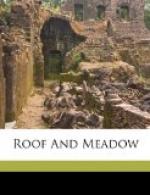Now, why should the sparrows of the roost prefer King’s Chapel Burial Ground to the Old Granary, a stone’s throw up the street? I passed the Old Granary yard on my way to the roost and found the trees empty. I searched the limbs with my glass; there was not a sparrow to be seen. Still, the Granary is the less exposed of the two. It may not formerly have been so; but at present high sheltering walls bend about the trees like a well. Years ago, perhaps, when the sparrows began to roost in the trees at King’s Chapel, the Old Granary elms were more open to the winds, and now force of habit and example keep the birds returning to the first lodge.
Back they come, no matter what the weather. There are a thousand cozy corners into which a sparrow might creep on a stormy night, where even the winds that know their way through Boston streets could not search him out. But the instinct to do as he always has done is as strong in the sparrow, in spite of his love for pioneering, as it is in the rest of us. He was brought here to roost as soon as he could fly, when the leaves were on and the nights delicious. If the leaves go and the nights change, what of that? Here he began, here he will continue to sleep. Let it rain, blow, snow; let the sleet, like a slimy serpent, creep up the trunk and wrap around the twigs: still he will hold on. Many a night I have seen them sleeping through a driving winter rain, their breasts to the storm, their tails hanging straight down, shedding every drop. If a gale is blowing, and it is cold, they get to the leeward of the tree, as close to the trunk as possible, and anchor fast, every bill pointing into the wind, every feather reefed, every tail lying out on the flat of the storm.
As I watched the bands starting from the tree-tops of the roost I wondered if they really crossed the river into Cambridge and Charlestown. A few mornings later I was again up early, hastening down to the West Boston Bridge to see if I could discover the birds going over. As I started out I saw bunches moving toward the river with a free and easy flight, but whether I reached the bridge too late, or whether they scattered and went over singly, I do not know. Only now and then did a bird cross, and he seemed to come from along the shore rather than from above the house-tops.
I concluded that the birds of the roost were strictly Bostonians. One evening, however, about a week later, as I was upon this bridge coming from Cambridge, a flock of sparrows whizzed past me, dipped over the rail to the water, swung up above the wall of houses, and disappeared toward the roost. They were on their way from Cambridge, from the classic elms of Harvard campus, who knows, to the elms of the ancient burial-ground.
It was five that April morning when the first sparrow left the roost. By half-past five the trees were empty, except for the few birds whose hunting-ground included the cemetery. By this time the city, too, had yawned, and rubbed its eyes, and tumbled out of bed.




